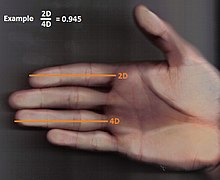

The digit ratio is the ratio taken of the lengths of different digits or fingers on a hand.
The most commonly studied digit ratio is that of the 2nd (index finger) and 4th (ring finger), also referred to as the 2D:4D ratio, measured on the palm side. It is proposed that the 2D:4D ratio indicates the degree to which an individual has been exposed to androgens during key stages of fetal development. A lower ratio has been associated with higher androgen exposure, which would be the physiological norm for males but may also occur in some exceptional circumstances in females. The latter include developmental disorders such as congenital adrenal hyperplasia.
The 2D:4D ratio has been postulated to correlate with a range of physical and cognitive traits in childhood and adulthood, including personality traits, such as assertiveness in women, aggressiveness in men and cognitive abilities such as numerical skills.[1] It has also been shown to vary considerably between racial groups[2] with males having, on average, lower 2D:4D ratio than females.[3]
Studies in this field have drawn criticism over questionable statistical significance and difficulties in reproducing their findings[4][5][6] as well as lack of high quality research protocols.[7]
- ^ Jeevanandam S, Muthu PK (2016). "2D:4D Ratio and its Implications in Medicine". Journal of Clinical and Diagnostic Research. 10 (12): CM01–CM03. doi:10.7860/JCDR/2016/21952.9000. PMC 5296424. PMID 28208851.
- ^ Cite error: The named reference
Manning_2000was invoked but never defined (see the help page). - ^ Nayak, Satheesha B.; Nair, Dhiviah; Ravi, Vimal; Aithal, Ashwini P. (20 September 2018). "A comparative study on digit ratio and hand patterns of three ethnic races of Malaysia". Egyptian Journal of Forensic Sciences. 8 (1): 56. doi:10.1186/s41935-018-0087-1. ISSN 2090-5939.
- ^ Kowal M, Sorokowski P, Żelaźniewicz A, Nowak J, Orzechowski S, Żurek G, et al. (June 2020). "No relationship between the digit ratios (2D:4D) and salivary testosterone change: Study on men under an acute exercise". Scientific Reports. 10 (1): 10068. Bibcode:2020NatSR..1010068K. doi:10.1038/s41598-020-66915-9. PMC 7308391. PMID 32572079.
- ^ Cite error: The named reference
Leslie_2019was invoked but never defined (see the help page). - ^ Cite error: The named reference
Jones_2020was invoked but never defined (see the help page). - ^ Cite error: The named reference
Smoliga_2021was invoked but never defined (see the help page).